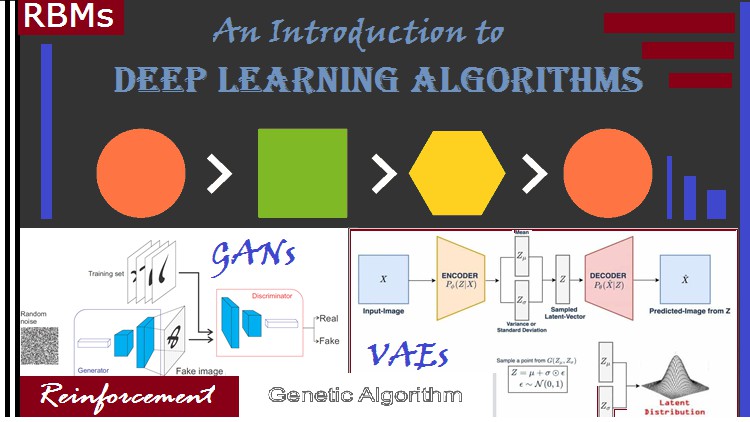Genetic, Generative & Variational Models in Machine Learning

- Description
- Curriculum
- FAQ
- Reviews
This course will provide a prospect for participants to establish or progress their considerate on the Genetic Algorithms, GANs and Variational Auto- encoders and their implementation in Python framework. This course encompasses algorithm processes, approaches, and application dimensions.
Genetic algorithm which reflects the process of natural selection though selection of fittest individuals is explained thoroughly. Further its implementation in Python Library is exhibited step- wise. Similarly, Generative Adversarial Networks, or GANs for short, are introduced as an approach to generative modelling.
Generative modelling is explained as an unsupervised learning task to generate or output new examples that plausibly could have been drawn from the original dataset. Both the Generator and Discriminator modules are explained in Depth. The two models are explained together in a zero-sum game, adversarial, until the discriminator model is fooled about half the time, meaning the generator model is generating plausible examples.
The course introduces elements of the research process within quantitative, qualitative, and mixed methods domains. Participants will use these underpinnings to begin to critically understand design thinking and its large-scale optimization. They would be able to develop an understanding to formulate a research question and answer it by framing an effective research methodology based on suitable methodologies. Furthermore, they would learn to derive meaningful inferences and to put them together in the form of a quality research paper.
In the last few years, deep learning based generative models have gained more and more interest due to (and implying) some amazing improvements in the field. Relying on huge amount of data, well-designed networks architectures and smart training techniques, deep generative models have shown an incredible ability to produce highly realistic pieces of content of various kind, such as images, texts and sounds. Among these deep generative models, two major families stand out and deserve a special attention: Generative Adversarial Networks (GANs) and Variational Autoencoders (VAEs).
The key topics covered in this course are;
1. An Introduction to Genetic Algorithms.
2. Implementation of Genetic Algorithms in Python using case examples.
3. Framing a hypothesis based on the nature of the study.
4. An Introduction to Generative Adversarial Networks (GANs).
5. Implementations of GANs in Python.
6. Meta-Analysis & Large Scale Graph Mining.
7. Design Thinking Using Immersion and Sense-Making.
8. An Introduction to Reinforcement Learning Algorithms in Deep Learning.
9. An Introduction Bayesian Statistical Inferences.
10. An Introduction to Autoencoders.
11. Concept of latent space in Variational Auto- Encoders (VAEs).
12. Regularisation and to generate new data from VAEs.
-
10Advanced Research Techniques including machine learning approachesVideo lesson
After this lecture students would learn the importance of systematic analysis and how it should be conducted.
-
11Why systematic Review and Meta Analysis is important for Evidence based studiesVideo lesson
Systematic reviews are convenient evidence based summaries which serve as a powerful tool for imperative decisions. They are considered to be the basis for guidelines of social science and medical practice suggesting directions for new research. These reviews, constructed through well-defined methods, have key role in Social Science Research and Evidence-Informed Health Care which means to apply new therapies and treatments. Systematic reviews provide a precise summary of a topic and have many advantages over narrative reviews. Meta-analysis is a technique which plays an important role in increasing the precision of systematic reviews.
Steps of preparation of a systematic review include:
1- Defining the review question
2- Search and selection of studies
3- Critical evaluation of studies for biases
4- Data Collection
5- Data analysis and presentation of results
6- Interpretation of results and drawing conclusions
7- Improving and updating reviews.
A reader should first be able to evaluate the quality of a systematic review before practicing the evidence provided by it as it helps to practice the provided evidence more effectively.

External Links May Contain Affiliate Links read more




